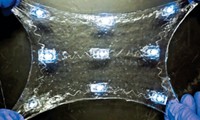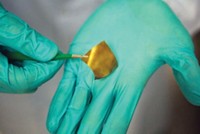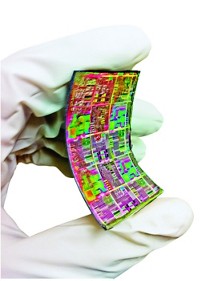Advertisement
Grab your lab coat. Let's get started
Welcome!
Welcome!
Create an account below to get 6 C&EN articles per month, receive newsletters and more - all free.
It seems this is your first time logging in online. Please enter the following information to continue.
As an ACS member you automatically get access to this site. All we need is few more details to create your reading experience.
Not you? Sign in with a different account.
Not you? Sign in with a different account.
ERROR 1
ERROR 1
ERROR 2
ERROR 2
ERROR 2
ERROR 2
ERROR 2
Password and Confirm password must match.
If you have an ACS member number, please enter it here so we can link this account to your membership. (optional)
ERROR 2
ACS values your privacy. By submitting your information, you are gaining access to C&EN and subscribing to our weekly newsletter. We use the information you provide to make your reading experience better, and we will never sell your data to third party members.
Materials
Silicon Circuits That Fold and Stretch
Devices could have novel biomedical applications
by Bethany Halford
March 31, 2008
| A version of this story appeared in
Volume 86, Issue 13

IMAGINE A SURGICAL GLOVE that can detect pH and oxygen levels in the precise part of the body where a surgeon is operating. Or consider a sensor that can wrap around an airplane's wings to monitor structural properties. Such stretchable, flexible devices could soon be a reality, thanks to a new type of silicon-based circuit (Science, DOI: 10.1126/science.1154367).
"The notion that silicon cannot be used in such applications because it is intrinsically brittle and rigid has been tossed out the window," says John A. Rogers, a materials science professor at the University of Illinois, Urbana-Champaign, who led the research effort along with Northwestern University engineering professor Yonggang Y. Huang.
By building ultrathin circuits with a crumpled structural layout, Rogers and Huang's team created electronics that can be stretched or bent to a radius of curvature as small as 85 μm without compromising their electronic properties.
"This work represents a major step forward in the field of flexible electronics," says Zhenan Bao, a chemical engineering professor and electronics expert at Stanford University. Rogers, Huang, and coworkers "made the normally brittle silicon stretchable and foldable. This approach should be applicable to a variety of materials," Bao adds.
In 2005, Rogers' team reported wavy silicon nanoribbons that could stretch and flex (C&EN, Dec. 19, 2005, page 13). Now, they have taken that idea and applied it to an entire circuit. "The core underlying concept is similar, but the implementation is orders of magnitude beyond what we did previously," Rogers notes. "I think the way that we're doing things now is applicable to electronic systems of arbitrary levels of complexity."
The researchers make the circuits by first applying a sacrificial layer of poly(methyl methacrylate) to a rigid substrate. This creates a base that allows them to use traditional circuit fabrication tools, despite the fact that the circuits they assemble on the base are extremely slim, about 1.5 μm thick. On top of the poly(methyl methacrylate), they cast a layer of polyimide, upon which they then use conventional fabrication techniques to lay down the device's components. Silicon nanoribbons are also printed onto the substrate.
Finally, they dissolve the sacrificial layer and bond the remaining circuit onto a piece of stretched silicone rubber. When the rubber snaps back to its original shape, it carries the circuit along with it, creating wrinkles in the material. These wrinkles allow the circuit to bend and stretch like accordion bellows. Thanks to an intensive mechanical analysis performed in Huang's lab, the circuit is designed so that the most fragile components experience the least strain.
"One thing I like about this work is that it doesn't involve new materials," Rogers notes. It presents new fabrication techniques and a new packaging strategy, he says, but the materials are familiar to electronics makers and don't face the uncertainties that new materials might.
"We're really trying to move electronics into realms where they were really not well suited," Rogers says. For example, the researchers are working with University of Pennsylvania neurology professor Brian Litt to make electronic sheets that could be stretched across the brain's surface to monitor and treat seizures in patients with epilepsy.







Join the conversation
Contact the reporter
Submit a Letter to the Editor for publication
Engage with us on Twitter